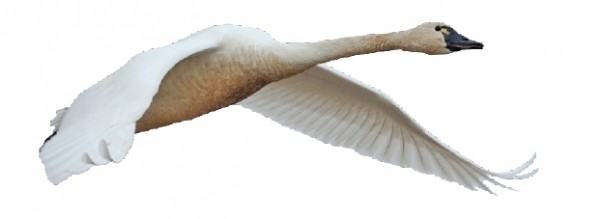The world feels like it’s vibrating. At the risk of sounding New Age-y, I can’t think of any better way to describe the movement I have felt in the air and the earth these past few weeks. In my garden, I find stout points of garlic pushing through softening soil. The other day, I watched a robin hop around between the bare canes of my rosebush, sending his voice to the sky. His warbles blended with the twitter and buzz of the other sounds of awakening.
And, at this very moment, no place is more alive with the energy of spring than the shores of the Great Salt Lake, where the annual migration of the tundra swan (Cygnus columbianus) is reaching its peak.
This great influx of birds can start at any time between February and early March. It’s as if from hundreds of miles away, the swans feel the thawing of ice in this little valley and begin to fly north. As the melt starts, they appear. At first, they come in the hundreds, then the thousands. At the migration’s peak, tens of thousands of white tundra swans descend, covering the water, the land, the air.
Even now, out in the bays and marshes of the Great Salt Lake, the tundra swans are announcing their presence. In these numbers, their calls become a dense mass of sound. Like the bubbling croak of frogs or the drone of crickets, the noise is ceaseless. But unlike the sharp honk of their geese cousin, the tundra swan’s woody call, similar to that of a crane, has a pleasant sweetness.
The swans’ bodies temporarily paint the landscape white. They are, after all, some of the largest waterfowl seen on the Great Salt Lake at any time of the year. Males weight up to 20 pounds; their wingspan can reach six feet. Where these birds float, the water is never calm. Where they stand and feed, their movement eclipses the sway of the reeds and grasses. They are a mighty presence, and watching them makes one feel like a visitor to a world that belongs wholly to birds.
In all, about 60,000 tundra swans move each year through Utah on their 4,000-mile journey from wintering grounds in southern California and northern Mexico to breeding grounds in the Arctic tundra. While they pass through, Utahns can catch a glimpse of the birds resting and feeding in protected wildlife management areas around the lake—places like the Ogden Bay Waterfowl Management Area near Hooper, Bear River Migratory Bird Refuge near Brigham City, and Cutler Reservoir in Cache County.
On Saturday, March 15, the Salt Creek Waterfowl Management Area, west of Corrine, will hold a free public viewing event. Representatives from Wasatch Audubon and the Department of Natural Resources will be present, ready with their knowledge of the birds and spotting scopes to help people get a closer look.
Unfortunately, those who go to see this mass migration of swans might be some of the last to witness the natural phenomenon. Around the world and all across the animal species, mass migrations are vanishing as suburbs eat up nesting grounds, and fences, dams and roads splice migration paths. Climate change affects seasonal cycles, alters insect hatches and shifts thawing times, throwing animals’ migration patterns into chaos.
While tundra swans have few natural predators, changing weather patterns and human obstacles are impacting theirpopulations. Early freezes and late springs are difficult for young birds in nesting areas. And even though the United States and Canada signed a waterfowl-management plan in 1986, protecting millions of acres of habitat for migrating waterfowl, human development continues to reduce the tundra swans’ range and habitat.
There are ways to help. Revenues from the purchase of federal duck stamps are used to acquire and maintain habitat for swans. Utah state income tax forms have a voluntary contribution item for wildlife conservation. And numerous local and national groups are working to preserve and protect wetlands and riparian areas around the Great Salt Lake.
But perhaps the most important thing to do is meet the birds. Watch as they swim and squonk. Marvel at the mating pairs performing their courtship dance, wings lifted and heads bowed low. Such a meeting can only convince us of the need to save these birds.
More by Katherine Pioli
-
Support Systems
Brine Dance and RDT work together to give showcase opportunities to dancers and choreographers.
- Sep 18, 2019
-
Feminine Mystique
Girl Child explores the trialsand treasures of being a woman.
- May 15, 2019
-
Oquirrh West Revival
A small company re-launches with the help of a big-name choreographer.
- Mar 20, 2019
- More »




